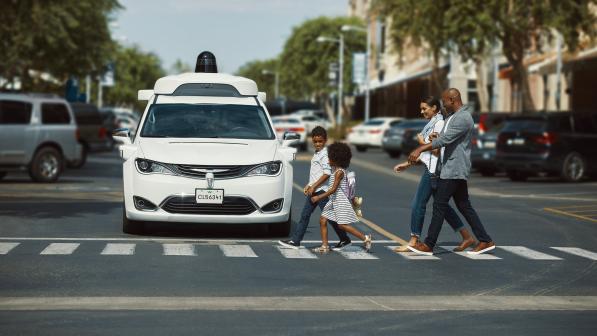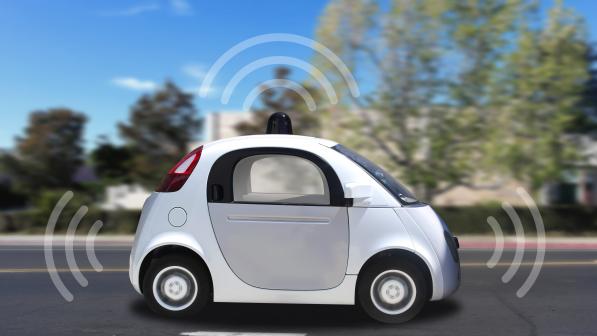Autonomous vehicles: automatically safer?

Car manufacturers have been promising us that newfangled driverless vehicles are just around the corner since at least the 1950s. How close are we to that reality? It’s difficult to tell, but the UK is taking a significant step forward with the introduction of the Automated Vehicles Bill. The legislation was introduced in November 2023, following its inclusion in the King’s Speech. It creates a legal framework for all vehicles which can drive independently of the driver for either part or the entirety of a journey.
We’ve long acknowledged that autonomous vehicles (AVs, or driverless cars) can benefit society by removing the source of many collisions (driver mistakes), freeing up road space, and decreasing the need for car ownership. However, depending on how they are regulated, driverless cars also have the potential to make our streets more dangerous, particularly for people who travel by foot or by bike.
As the Automated Vehicles Bill has been making its way through the Lords, Cycling UK has been actively seeking to introduce amendments that ensure safety for cyclists.
Driverless cars must make roads safer for everyone, not only those in cars
As it's currently written, the Automated Vehicles Bill would allow driverless cars to be authorised when it has been demonstrated that they drive “to an acceptably safe standard”, “with an acceptably low risk of committing a traffic infraction”, and result in “road safety in Great Britain [being] better as a result of the use of authorised automated vehicles on roads than it would otherwise be”.
For us, these standards are simply far too low. We don’t just need better road safety, we need significantly better road safety. We also want to avoid a future possible scenario in which AVs bring about a net safety gain because they make car occupants safer, but actually make other road users less safe because it's harder for AVs to detect and predict the behaviours of people on foot or on a bike.
At present, the risks of death or injury on our roads are significantly higher than for life in general, or indeed on other transport networks.
Pedestrians, people who cycle and other non-motorised road users disproportionately bear the brunt of this risk, with children, older people and people with disabilities being particularly vulnerable.
This imbalance between the road users who cause danger and those who are endangered is a significant obstacle to maximising the health, environmental and other benefits of increased walking and cycling.
Roger Geffen, policy director at Cycling UK
To address our concerns, we have proposed an amendment that would authorise driverless cars as safe only if they can drive as safely as a human driver who passes their practical driving test with no faults. We have also proposed an amendment which ensures that driverless cars must result in improved safety for all road users, not only those in cars.
Autonomous vehicles should be introduced in stages
Real life tragedies have indicated that autonomous vehicles are better at predicting the behaviour of other cars than of pedestrians and cyclists. We believe it's critical that AVs must demonstrate that they can mix safely with all road users before being allowed onto streets used by people walking, wheeling and cycling.
That’s why we have long advocated for a phased approach, in which driverless cars are initially allowed only on motorways and other car-only environments, so that they can continue to demonstrate and improve their safety. The Government has indicated support for such an approach, but we have nonetheless suggested an amendment that would make it more likely.

The legal system must protect cyclists following collisions with driverless cars
Cycling UK has long criticised the fact that the UK is one of only a few European countries which lack presumed liability. This means that in the UK, when cyclists or pedestrians are injured in collisions with a car, it's their responsibility to prove that the driver caused the collision. This creates an ‘inequality of arms’, because pedestrians and cyclists are much less likely to have insurance and are more likely to be seriously injured in a collision and have trouble recalling the event.
We're concerned that this inequality will only be magnified with the introduction of driverless cars. That’s why our amendment would ensure that when cyclists, pedestrians or horse riders are injured in a collision with an AV, the vehicle is assumed to be at fault and therefore the manufacturer or operating system liable unless proven otherwise.
What’s coming up in Parliament
We're grateful to Lord Hampton, Lord Liddle and Baroness Randerson for having tabled our amendments to the Automated Vehicles Bill.
We hope the Government sees the sense in our suggestions next Tuesday, 6 February, when the bill will move to the Report Stage debate, approaching the end of the Lords stages before being considered in the Commons.



